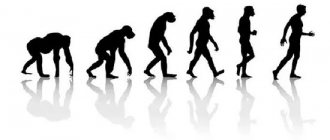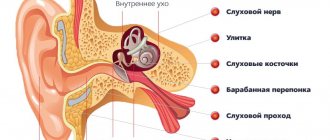Dryopithecus
The world scientific community calls the very first people Dryopithecus. It is generally accepted that they were exactly the same as monkeys. Dryopithecus even walked on four limbs. They supposedly lived more than 9 million years ago in East Africa and Eurasia.
Anthropogenesis
Dryopithecus were short apes. They could not make even the simplest tools, did not know how to build huts for housing, and ate mainly berries. Covered with a thick layer of fur, Dryopithecus did not need clothing. However, as time passed, Dryopithecus began to evolve. Their brains were very small and measured about 305-320 cm3.
Australopithecus
Australopithecines are the descendants of Dryopithecus. They lived on Earth about 4 million years ago. The African steppes were considered the main zone of their settlement. Bones and fossilized remains that belonged to them are still found there. Compared to their predecessors, Australopithecines were very well developed. Some scientists, for example, H. S. Lipson, who study human evolution, are confident that this particular species of ape played a decisive role in the formation of modern man - Homo sapiens (reasonable man).
Among the characteristic features of Australopithecus, a number of factors should be highlighted:
- The jaw was relatively weak.
- The fangs that protruded outward were completely absent.
- The brain is well developed, its volume was about 530 cm3.
- Male Australopithecines were almost 50% larger and heavier than females.
- In Australopithecines, representatives of this stage of evolution, the anterior hand began to develop, which led to the formation of a grasping reflex. Now it was not difficult for them to take an object and move it from one place to another.
- Australopithecus was one of the first to learn to walk with an upright gait. How they were able to do this is still unclear.
- For hunting, they could use improvised means at the same level as modern gorillas, who can crack nuts using large stones.
- The height was generally 1-1.5 meters.
- Due to the fact that australopithecines had to descend from the trees to land, the foot began to straighten a little.
Prerequisites and driving forces of anthropogenesis
The common ancestors of humans and apes were gregarious, tree-dwelling monkeys in tropical forests. The cooling of the climate and the displacement of forests by steppes caused the transition of these monkeys to a terrestrial lifestyle and to upright walking. The straightened position of the body and the transfer of the center of gravity caused the replacement of the arched spine with an S-shaped one, which gave it flexibility.
An arched springy foot formed, the pelvis expanded, the chest became wider and shorter. The jaw apparatus has become lighter. The forelimbs were freed from supporting the body to perform a complex of more complex functions.
The transition from using objects to making tools is the boundary between ape and man. The evolution of the hand proceeded through the natural selection of mutations useful for work activity. So, the hand is not only an organ of labor, but also its product.
The use of plants and animals for food ensured its diversity and calorie content. The use of heat treatment of food reduced the load on the masticatory and digestive apparatus, which led to anatomical and morphological changes (the parietal ridge, where powerful masticatory muscles are attached, disappeared, and the digestive tract became shorter).
In addition to upright walking, a prerequisite for anthropogenesis was a herd lifestyle. The need to exchange signals led to the development of articulate speech. Work and articulate speech were the factors that controlled the genetically determined evolution of the human brain and sense organs. Ideas about surrounding objects and phenomena were generalized into abstract concepts, mental and speech abilities developed, and higher nervous activity was formed.
The transition to upright walking, a herd lifestyle, a high level of brain development, the use of objects as tools for hunting and protection are the main prerequisites for anthropogenesis, on the basis of which labor activity, speech and thinking developed and improved.
The driving forces of anthropogenesis in the first stages were the basic biological patterns that were also characteristic of other biological species. But already in the early stages of human evolution, social factors also began to come into force, which in the later stages (especially after the emergence of the species Homo sapiens) became increasingly important, and at the present stage are of paramount importance.
Modern man is both a biological and a social being. Its development is greatly influenced by social factors. But the mutation process also retains its role as a source of genetic variability. Biological evolution is weakened due to the decreasing role of natural selection, and the viability of human society increases due to more intensive gene exchange due to the high mobility of individual representatives of humanity.
Humanity is able to control its evolution through the following processes:
1) protection from exposure to mutagens;
2) development and application of methods for the treatment of hereditary diseases;
3) development of human abilities by increasing the level of training and culture.
A skilled man
Homo habilis also played a significant role in human evolution. He lived on earth about 2.8 million years ago. The brain volume was 600-700 cm3. This is significantly higher than that of the same australopithecines. Weight – about 50 kg. Height is approximately 1.2 meters. The shape of the skull has also changed. Now she began to look more rounded.
Important! The main merit of a skilled person is that he learned to make primitive tools. They were mainly made of quartz, which they brought from great distances. Thanks to this skill, skilled people had the opportunity to hunt better and get more food.
The foot became flatter, which made it possible to move better and faster on the ground. However, the big toe was still “stuck” to all the others. Their teeth were much smaller than those of their predecessors, but too large compared to the teeth of modern humans.
General characteristics of human predecessor species
About 35 million years ago, a group of animals separated from the ancient insectivorous mammals, from which primates subsequently arose, with characteristics close to the living primitive primates - tupayas.
A branch separated from the ancestors of modern tupai, which gave rise to Parapithecus. Parapithecus were small animals that led an arboreal lifestyle and fed on insects. They gave rise to two branches, one of which evolved into modern orangutans and gibbons, and the other into the now extinct group of arboreal apes, Dryopithecus.
Some Dryopithecus adapted to life in tropical rain forests and gave rise to the ancestors of gorillas and chimpanzees.
The cooling of the climate and the displacement of tropical and subtropical forests to the south led to the formation of vast open spaces with savanna-type vegetation. This led to the fact that one of the branches of Dryopithecus adapted to habitats where these animals had to stand on their hind limbs, which was the first step towards upright walking. Under new conditions, this trait turned out to be positive and was fixed in the process of natural selection. For Dryopithecus, upright walking was an aromorphosis, as it freed the forelimbs from the function of movement for new functions (finding food, obtaining it with the help of foreign objects, caring for cubs, etc.). This branch of Dryopithecus marked the beginning of the evolution of human predecessors - Australopithecines.
Australopithecines (Australis - southern, Pithecus - monkey, i.e. southern monkeys) are an extinct group of hominids (upright primates). Their remains were found in South Africa. They lived about 5 million years ago. Many features of these organisms are similar to humans, but the brain size did not exceed that of modern apes and amounted to 650 cm3. Later representatives (branch) of Australopithecus became the ancestors of humans. Natural selection contributed to the survival of individuals and groups with the ability to work.
Two to three million years ago, Australopithecines gave rise to a new branch of organisms - Homo habilis. These animals were able to make primitive cutting and chopping tools from pebbles. Morphologically, these organisms differed little from australopithecines, but they had a larger brain volume (by 100 cm3), a greater level of development, which made it possible to create a culture, albeit a primitive one, and to overcome the line separating fossil apes from ancient people.
Homo erectus
The main habitat of Homo erectus was East Africa. It appeared there more than 1.6 million years ago. In a short period of time, it multiplied and occupied a much larger habitat. It even included Europe and Asia. The characteristic features of this person were:
- Height up to 1.8 meters.
- The straight gait was now clearly defined.
- Ability to make various stone tools. Compared to quartz, they were much harder and stronger. However, their production took quite a long time.
- In order to endure different seasons, they used the skins of animals that they killed while hunting.
- Homo erectus lived mainly in caves.
- The most important achievement was the ability to use fire. This made it possible to speed up the pace of cooking.
- They were cannibals, that is, they could eat killed enemies.
ANTHROPOGENESIS
Anthropogenesis
(Greek anthröpos man + genesis origin, origin) - the process of evolutionary-historical formation of man.
Anthropogenesis is the subject of a special section of anthropology (see). Rice.
1. Apes (anthropoids): 1 - chimpanzees; 2 - gorilla: 3 - orangutan; 4 - gibbon. Rice. 2. Scheme of the family tree of primates: 1 - prosimians (lemurs); 2 - canine (monkey-like) monkeys; 3 - small anthropoids (gibbons); 4 - modern man and his races; 5 - large anthropoids (chimpanzees, gorilla, orangutan); 6 - broad-nosed (American) monkeys; 7 - tarsiers (tarsians). Elements of a materialistic view of nature took place in the works of ancient philosophers - Democritus, Epicurus, Lucretius, etc., but only after the era of the reactionary Middle Ages did the materialist worldview penetrate into all areas of science, including medicine and biology. A reflection of this worldview in biology were attempts to create a theory of the evolution of the organic world. But a truly materialistic interpretation of the evolutionary process received its further development only in the works of Charles Darwin: “The Origin of Species by Means of Natural Selection” (1859), “Changes in Domestic Animals and Cultivated Plants” (1868), etc. In 1871, he published a large work on theory of evolution “The Origin of Man and Sexual Selection”, where he provided numerous evidence of the origin of man from animal ancestors and that his closest relatives are apes. In terms of anatomical and physiological characteristics, humans are undoubtedly a higher primate, close to apes (Fig. 1). The relationship of humans with great apes is confirmed by the similar structure of the skeleton, muscles, brain, biochemical characteristics of the blood (see Monkeys, Humans), and data on embryonic development (see Biogenetic Law). Human ontogenesis clearly demonstrates the presence of a tail and grasping feet in his ancestors, which is associated with climbing trees. Important evidence of human origin from animals are rudimentary organs (see) and atavisms (see). Numerous bone remains (teeth, jaws, skulls, skeletal bones) of fossil prosimians and their descendants - monkeys (including apes - the closest ancestors of humans) indicate the gradual accumulation of characteristics characteristic of modern humans during the evolution of primates (Fig. 2). One of the transitional forms of lower primates to primitive representatives of higher apes is the Mogaung amphipithecus (Amphipithecus mogaungensis), discovered in the Upper Miocene deposits in Burma. The remains of the most ancient representatives of apes (parapithecus, propliopithecus, etc.) were found in Oligocene layers in Egypt near Fayoum.
In Soviet anthropology, it is customary to divide the process of anthropogenesis into three stages: I - anthropoid ancestors of humans such as Australopithecus, II - ancient (archanthropes) and ancient people (paleoanthropes) and III - neoanthropes (fossil and modern Homo sapiens). The formation of man at the stage of archanthropes and paleoanthropes was associated with the biological evolution of these people; with the advent of neoanthropes, the era of dominance of social laws is established (Ya. Ya. Roginsky, 1967) without further significant morphological transformations of human species characteristics.
Rice. 3. Transvaal Australopithecus skull.
At the origins of the family of hominids (Hominidae) there is a group of fossil apes - large anthropoids: they belong to the family. pongid (Pongidae). These are the Dryopithecus of Asia and Africa and the Ramapithecus of Asia, who lived in the Miocene era (25-10 million years ago). The reduction in forest areas and their thinning due to the increasing aridity of the climate led to the development of a new method of movement among anthropoids - on two legs. Some species of these monkeys in Africa and Asia have adapted to obtain meat food using sticks or stones. Natural objects used as tools protected them from predators; the struggle for their own existence created the need to live in a community. In the process of evolution, higher nervous activity progressed in certain species of anthropoids. The “model” of the Pliocene and later anthropoid ancestors of humans are, in most cases, some more developed representatives of the Australopithecines of Africa (Fig. 3). Among them, the most famous is the so-called Homo habilis - a skilled person. Its skeletal remains, dating back about 2 million years, were found in the Olduvai Gorge in East Africa. The purposeful production of tools of a fixed form (which indicates the emergence of abstract figurative ideas about a tool) is associated with the development on Earth of a qualitatively special living creature - a human being, although still with a pronounced ape-like appearance. This new stage in anthropogenesis is characterized by the beginning of truly human labor activity.
The emergence and evolution of humans are quite clearly distinguished from the purely biological course of development of other animal species. Charles Darwin assigned the main role in anthropogenesis to biological factors - natural selection, variability, heredity. From the standpoint of the dialectical-materialist theory, anthropogenesis is characterized as a qualitatively special shift in the development of the animal world, as a decisive turn in the process of biological evolution, leading to the emergence of a new quality. The main driving force of the process of anthropogenesis is the social production and use of tools and production. In the primitive herds of ancient people, qualitatively new social patterns arose and intensified. This theory of anthropogenesis, proposed by F. Engels, allows us to understand the complex essence of the entire history of the evolution of people, who rose unusually high above the entire world of living beings.
Rice. 4. Skulls of ancient people (Pithecanthropus): 1 - Pithecanthropus I; 2 - Pithecanthropus IV; 3 and 4 - Pithecanthropus VIII, side view (3), front view (4). Rice. 5. Lower jaws of ancient people: 1 - atlantropa; 2 - Heidelberg (Mauer) man.
The earliest humankind descended from one species of fossil apes that lived across a large area of South Asia and North-East Africa (the theory of monogenism). Many anthropologists are inclined to consider Africa as the ancestral home of humans, since the closest relatives of humans - chimpanzees and gorillas - live there. There is also a hypothesis about the origin of human ancestors from several species of monkeys (the theory of polygenism): as if the ancestors of the white race descended from chimpanzees, the yellow race from the orangutan, and the black race from the gorilla. However, the proximity of races and their free cross-breeding confirm the correctness of the theory of monogenism, that is, the origin of man from only one type of ancestor.
Humans, or hominids in the narrow sense, appeared on Earth in the middle of the Pleistocene (Anthropocene) era, about 1 million years ago. Hominids in the broad sense could have separated from the superfamily of hominoids (Hominoidea) shared with pongids approximately 15 million years ago, in the middle of the Miocene; they included human ancestors and closely related fossil anthropoid forms. The most reliable bone remains of the most ancient ape-men (archanthropes) were found in sediments dating back 700-500 thousand years in Asia, Europe and Africa. A series of Pithecanthropus skulls were found on the island. Java (Fig. 4). The structure of the skulls of Pithecanthropus is similar to the skulls of Chinese ape-men, or Sinanthropus, who lived about 400 thousand years ago. The capacity of their cranium (915-1125 cm3) is greater than that of Pithecanthropus (775-900 cm3). The height of Pithecanthropus is about 165-170 cm, Sinanthropus is 152-163 cm. Heidelberg man is one of the most ancient people who lived in Europe. It is known only from the lower jaw (Fig. 5, 2). In the Arago grotto, 19 km from Perpignan (France), the skull of a very primitive man who lived about 200 thousand years ago was found. Remains of archanthropes have been found in Africa. In Algeria, 17 km from the city of Maskara, three so-called lower jaws were discovered. atlantropov (Fig. 5, 1). Thus, archanthropes were widely distributed throughout Africa, Europe and Asia and were characterized by significant morphological variability.
Rice. 6. Skulls of ancient people (Neanderthals): 1 - skull found near Skhul (Mount Carmel): 2 - skull found in La Chapelle-aux-Saints (France).
The next stage of human evolution is represented by paleoanthropes - ancient people, or Neanderthals (Fig. 6). Their skulls were first found: in 1848 in Gibraltar (Spain) and in 1856 in Neanderthal (Germany). The remains of similar primitive people (skulls, jaws, teeth and bones) were also discovered in Europe, Asia, Africa and on the territory of the USSR in sediments dating back 200-35 thousand years. They are characterized by: a sloping forehead, a solid bony supraorbital ridge, a large facial part, and the absence of a mental protuberance on the lower jaw. However, there are many skulls of ancient people with a softened relief, with a weakly defined chin protrusion.
The material culture of the Neanderthals is represented by stone tools—pointed points, scrapers, and rubles. The tools of the previous eras of the Lower (Early) Paleolithic, namely the Chelles and Achelles (hand axes, etc.), were more primitive. Thus, the biological evolution of the human body is mutually and closely related to the development of material culture.
Rice. 7. Fossil skulls of modern people (neoanthropes): 1 - skull from the Grotto of Children near Menton (Italy); 2 - skull found in the village. Kostenki (near Voronezh).
As a result of the long process of formation of the human body, modern people arose (Fig. 7) - Cro-Magnons and other fossil representatives of the species Homo sapiens. According to F. Engels, “formed people” turned into “ready people.” Modern people are often called neoanthropes.
The study of the origin of neoanthropes from paleoanthropes is of great scientific importance in the light of solving the problem of the ancestral home of the racial trunks of modern man. Most anthropologists are increasingly inclined to believe that the ancestors of Kamineoanthropes were not “classical” Western European Neanderthals, such as those found in La Chapelle-aux-Saints (France) or Monte Circeo (Italy), but more ancient forms that lived in the territory of the Middle and Front Asia and Northeast Africa.
The appearance of neoanthropes is associated with the last (Würm) ice age. They were the creators of higher material cultures than the Chelles or Acheulian - the Solutrean, Aurignacian, Seletian and Magdalenian eras of the late, or upper, Paleolithic. The absolute antiquity of modern humans is estimated at 35-40 thousand years. The territory occupied by modern humans was wider than the original homeland of humanity and probably covered South and Western Asia, the eastern Mediterranean, East Africa, and regions of Western and Eastern Europe. In anthropology, the more common concept of the development of the species Homo sapiens and its races in one broad area (ecumene, from the Greek oikumene - inhabited earth) is the hypothesis of broad monocentrism. The formation of the main races of modern humanity may have occurred after the emergence of the main type of structure of modern man (V.V. Bunak, 1956). Proponents of polycentrism [F. Weidenreich, 1943, etc.] believe that there were four regions (centers) where the Australoid, Mongoloid, Caucasoid and Negroid large races allegedly formed. The anatomical and physiological fundamental kinship of all racial groups of modern humanity and their mental equivalence (see Races) are a significant confirmation of the correctness of the theory of monocentrism.
The driving forces of anthropogenesis in the early stages were natural factors. Later, social patterns began to dominate. Thus, natural selection, which had a more noticeable influence on the phases of evolution of the most ancient and ancient people, gradually, as the role of labor increased, weakened, but variability and heredity continued to influence, although in slightly different forms of combining anatomical and physiological characteristics under the more powerful influence of social factors.
In the process of social labor, thinking developed, man mastered speech, and his material and spiritual culture was formed. And, although he “bears in his physical structure the indelible stamp of his lower origin” (C. Darwin), identifying him with an animal, as well as attributing to the latter complex abstract, conceptual thinking, reason, and a second signaling system, is unacceptable. Despite the appearance of the “division of labor” in animal communities, their complex structures, human labor is qualitatively different from the activities of animals: only man was able to create artificial tools, develop abstract thinking and purposefully apply it in the sphere of material production.
The problem of anthropogenesis is “a question among the questions of humanity” [Gekeli (T. N. Huxley), 1863]. Developing a correct view of the origin and essence of the human body is of very great theoretical and practical importance.
Bibliography:
Marx K. and Engels F. Works, 2nd ed., vol. 20, p. 343, M., 1961, t. 23, M., 1960; Lenin V.I. Complete Works, 5th ed., vol. 33, p. 100, M., 1962; Bunak V.V. The human skull and the stages of its formation in fossil people and modern races, Proceedings of the Institute of Ethnography of the USSR Academy of Sciences, vol. 49, M., 1959; Gremyatsky M.A. Primates squad, Primates, in the book: Fundamentals of Paleontology, ed. Yu. A. Orlova, t. 13, p. 90, M., 1962, bibliogr.; Danilova E.I. Evolution of the hand in connection with issues of anthropogenesis, Kyiv, 1965, bibliogr.; Darwin Ch. Works, trans. from English, vol. 5, M., 1953; Ivanova I.K. Geological age of fossil man. M., 1965, bibliogr.; Kochetkova V.I. Paleoneurology, M., 1973, bibliogr.; Ladygina-Kots N. N. Constructive and instrumental activity of higher apes (chimpanzees), M., 1959, bibliogr.; Nesturkh M.F. Primatology and anthropogenesis (monkeys, prosimians and the origin of man), M., 1960; aka, Human Races, M., 1965; aka, The Origin of Man, M., 1970, bibliogr. ; Roginsky Ya. Ya. Problems of anthropogenesis, M., 1969, bibliogr.; Semenov Yu. I. How humanity arose. M., 1966, bibliogr.; At the origins of humanity (the main problems of anthropogenesis), ed. V. P. Yakimova, M., 1964, bibliogr.; Uryson M.I. Origins of the hominid family and phylogenetic differentiation of higher primates, in the book: Man (evolution and intraspecific differentiation), ed. V. P. Yakimova, p. 9, M., 1972; Shevchenko Yu. G. Evolution of the cerebral cortex of primates and humans, M., 1971, bibliogr.; Yakimov V.P. Australopithecinae, in the book: Fossil hominids and the origin of man, ed. V. V. Bunaka, p. 43, M., 1966, bibliogr.; The Amud man and his cave site, ed. by H. Suzuki a. F. Takai, Tokyo, 1970; Buettner-Janusch J. Origins of man, physical anthropology, NY, 1966, bibliogr.; DobzhanskyT. Mankind evolving, the evolution of the human species, New Haven - L., 1966, bibliogr.; Evolution und Hominisation, hrsg. v. G. Kurth, Stuttgart, 1968, Bibliogr.; Quigle C. Assumption and inference on human origins, Cur. Anthropol., v. 12, p. 519, 1971, bibliogr.; SartonoS. Observations on a new skull of Pithecanthropus Erectus (Pithecanthropus VIII) from Sangiran, Central Java, Proc. kon. ned. Acad. Wet. Ser. B, v. 74, p. 185, 1971, bibliogr.
See also bibliogr, to Art. Anthropology.
M. F. Nesturkh.
Neanderthals
The second name for this branch of human evolution is paleoanthropes (Homo neanderthalensis). According to scientists, Neanderthal man appeared on earth about 200 thousand years ago. Its last representatives died out about 30 thousand years ago. The main activity of this species was hunting. It also served as the main means of subsistence. Possessing already quite good weapons, the Neanderthals could bring so much food in one hunt that it was enough for the entire tribe for several weeks. And thanks to his powerful physique and height of about 170 cm, tracking down prey and killing it was not so difficult.
The brain volume of Neanderthals was 1000-1700 cm3. This type was of two types:
- European
- West Asian
The face of Neanderthals protruded very much forward, as did the back of the head. The powerful jaw hung down, and the sloping forehead gave these people a more menacing appearance.
Important! They no longer lived in caves, but in their own shelters, which were built using branches and animal skins. Neanderthals knew how to easily make a fire. Thanks to all these skills, they easily adapted to any natural conditions.
Homo sapiens
Homo sapiens appeared between 100 and 160 thousand years ago. The average weight of men was about 80 kilograms, the weight of women was slightly less - 75 kg. The height of the former is about 180 cm, and the height of the latter is 165 centimeters. The average life expectancy reached 79 years. It is not for nothing that Homo sapiens received such a name. He was truly the smartest of all the representatives creating evolution. Homo sapiens was the first who was able to create a bow and arrows and use them to hit animals at a distance. This invention improved hunting significantly.
Now they did not have to watch their every step, because the flight range of an arrow fired from a reasonable person’s bow was about 300 meters; with an accurate hit, the game fell dead right there.
Fishing became possible with the help of bone harpoons and wooden boats carved from tree trunks. Homo sapiens improved the dwellings of his ancestors and made them more similar to those in which numerous African tribes or Indians live today. Sometimes the dwellings were a large pit with a roof, the inside of which was decorated with wooden frames. Homo sapiens also created a kind of household items that were decorated with a wide variety of designs. Homo sapiens, at the last stage of his development, acquired all the traits that today's people possess. A straight gait, the same foot, hands capable of squeezing and grasping, an oval face without parts protruding forward - all this made Homo sapiens truly human.
This type of evolved man for the first time realized the whole essence of social life. Now people lived in large communities that had a lot in common. At the head of such a community was a leader. He decided what punishment to apply to whom, selected warriors for hunting, and led military operations with neighbors.
Important! At this stage of development, not only art, but also oral and some written speech became widespread. The need for gestures has disappeared. If someone needed something, he could simply ask for it.










